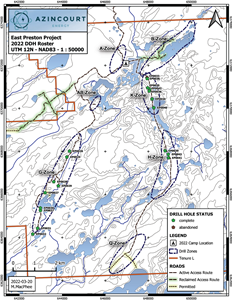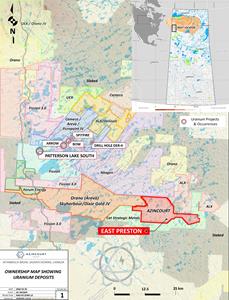Azincourt Energy Identifies Uranium Enrichment at the East Preston Project
VANCOUVER, British Columbia, July 13, 2022 (GLOBE NEWSWIRE) -- AZINCOURT ENERGY CORP. (“Azincourt” or the “Company”) (TSX.V: AAZ, OTCQB: AZURF), is pleased to present the analytical results from the Winter 2022 drill program at the East Preston uranium project, located in the western Athabasca Basin, Saskatchewan, Canada.
Drilling for the 2022 winter season at the East Preston Project resulted in 5,004.5 meters completed in 19 drill holes between January and March of 2022. Preliminary results of this program were reported in a news release dated March 29th, 2022. Drilling during the 2022 program focused on the A-G and K-H-Q trends and commenced in the G-Zone where the 2021 drill program ended (Figure 3).
A total of 420 samples were collected throughout the program and sent to the Geoanalytical Laboratory at the Saskatchewan Research Council in Saskatoon, Saskatchewan for analysis. After unexpected delays at the lab, results were finally received by TerraLogic Exploration in late June and immediately underwent a thorough quality control assessment prior to being accepted.
“The analysis from drill core is encouraging,” said VP, Exploration, Trevor Perkins. “The uranium enrichment within the alteration zones is a sign that uranium bearing fluids were present within the alteration system. We have the alteration system, and uranium moving around within it. The next step is identifying the areas of concentration within the system where significant uranium is dropping out,” continued Mr. Perkins.
An analysis of the results shows uranium enrichment within the previously identified alteration zones along the G, K, and H target zones (Figure 2). Uranium enrichment is identified as uranium (U) values and a uranium/thorium ratio (U/Th) above what would normally be expected in the given rock type or area.
Along the northeast trending G-Zone, extensive hydrothermal alteration, and evidence of east-west cross-cutting structures were highlighted in holes EP0030 and EP0037. The primary rock types in the alteration zone are granodiorite and diorite gneiss with average expected values of 2-3 ppm U and U/Th ratios of 0.25-0.3. A sample from Hole EP0037 returned 14.6 ppm U and a U/Th ratio of 1.5, five times the expected values. A sample from EP0032 returned 19.5 ppm U and a U/Th ratio of 0.8.
The H-Zone covers a change in orientation of the structural and conductive trend from north south to southwest trending and contains a thick zone of hydrothermal alteration and an intense graphitic fault and mylonite zone. A sample from EP0041 retuned 12.5 ppm U and a 0.5 U/Th ratio within a mylonite in the fault zone.
Along the north-south trending K-Zone extensive zones of hydrothermal hematite have been intersected in all holes, with clay alteration also being present. A zone of localized elevated radioactivity more than 10 times background values was identified in EP0035 (Azincourt Energy news release dated March 1st, 2022). The rock type in this zone is gabbro with average expected values of 0.5-1.5 ppm U and U/Th ratios of 0.25-0.5. A sample from this zone in EP0035 returned 5.4 ppm U and a 1.2 U/Th ratio.
The company considers sample analysis results to be an important indicator that uranium bearing fluids were present within the alteration systems identified. Continued testing of the alteration system to identify the extents of the alteration and areas of fluid concentration and strong uranium enrichment will be the aim of follow-up programs.
“The results of this drill program continue to support our exploration model at East Preston,” said President and CEO, Alex Klenman. “The alteration zones are considerable in both size and scope. The results now confirm uranium is present within these alteration zones, which is a significant and critical step in the exploration process. We are eager to get the next round of drilling completed as the knowledge gained from this winter’s program will aid immensely in vectoring toward areas of more significant mineralization,” continued Mr. Klenman.
A thorough review and interpretation of the results of the winter 2022 program at East Preston is underway and preparation for an extensive follow up program in the winter of 2022-2023 is planned to continue evaluating alteration and structure on the G-, K-, and H-Zones as well as get a first look at the Q-Zone.
The Company is also planning to complete its first drill program at the 13,711-ha Hatchet Lake project, located along the Wollaston Domain on the northeastern side of the Athabasca Basin, in September and October of this year. This well known structural corridor hosts the majority of known high-grade uranium deposits and all of Canada’s operating uranium mines. High-grade mineralization, up to 2.43% U308, has already been established at Hatchet Lake. Azincourt is earning up to 75% interest in the project as part of an earn-in agreement with ValOre Metals. The permitting and consultation process is in progress, and updates will be provided over the next several weeks.
“The next eight to ten months will be busy for Azincourt as we follow up at East Preston, and we also begin drilling at Hatchet Lake, which we plan to drill as early as this fall,” said Mr. Klenman. “Despite the recent decline in overall market sentiment, we’re in an excellent position. Our treasury is extremely strong, and we’re fully funded to execute all of our exploration plans over the next year, and beyond. We’re going to be very active and plan to be aggressive with the drills,” continued Mr. Klenman.
Webinar Today
The Company will be conducting a live webinar, in conjunction with Red Cloud Securities, to discuss the drill results in more detail, today Wednesday, July 13, at 11am PST/2pm EST. We invite readers to register and attend, please follow this URL to participate:
https://redcloudfs.com/rcwebinar-aaz-3/
East Preston Target Areas
The primary target area on the East Preston Project is the conductive corridors from the A-Zone through to the G-Zone (A-G Trend) and the K-Zone through to the H and Q-Zones (K-H-Q Trend) (Figures 1 and 3). The selection of these trends is based on a compilation of results from the 2018 through 2020 ground-based EM and gravity surveys, property wide VTEM and magnetic surveys, and the 2019 through 2022 drill programs, the 2020 HLEM survey indicates multiple prospective conductors and structural complexity along these corridors.
Drilling programs to date have confirmed that identified geophysical conductors comprise structurally disrupted zones that are host to accumulations of graphite, sulphides, and carbonates. Hydrothermal alteration, anomalous radioactivity, and elevated uranium have been demonstrated to exist within these structurally disrupted conductor zones.
While the A-G and K-H-Q trends are the primary focus, many additional trends and zones exist to the east and west of the primary trends on the East Preston property (Figure 1). These additional target areas will require ground geophysics to constrain conductor locations and drilling to properly evaluate their potential.
Permitting and Community Engagement
The permitting process is underway to obtain authorization for the winter 2022-2023 drill program. Azincourt Energy continues to be engaged in regular meetings with the Clearwater River Dene Nation and other rights holders to ensure that concerns of the local communities are addressed. Azincourt looks forward to a continued close working relationship with CRDN and other rights holders to ensure that any potential impacts and concerns are addressed and that the communities can benefit from activities in the area through support of local business, employment opportunities, and sponsorship of select community programs and initiatives. Several members of the Clearwater River Dene Nation were directly employed on site or to provide support and services to keep the camp and program running.
https://www.globenewswire.com/NewsRoom/AttachmentNg/6f71eb63-ed77-4b29-a2c6-348ea24a15e3
Figure 1: Target corridors at the East Preston Uranium Project, Western Athabasca Basin Saskatchewan
https://www.globenewswire.com/NewsRoom/AttachmentNg/0aa363aa-2342-4a4b-97c5-0a20f3e7fae2
Figure 2: 2022 Drill Holes and Target areas at the East Preston Uranium Project
https://www.globenewswire.com/NewsRoom/AttachmentNg/0aef4a37-d9e6-48dc-97f6-771b890422ac
Figure 3: Project Location – Western Athabasca Basin, Saskatchewan, Canada
About East Preston
Azincourt controls a majority 72.8% interest in the 25,000+ hectare East Preston project as part of a joint venture agreement with Skyharbour Resources (TSX.V: SYH), and Dixie Gold. Three prospective conductive, low magnetic signature corridors have been discovered on the property. The three distinct corridors have a total strike length of over 25 km, each with multiple EM conductor trends identified. Ground prospecting and sampling work completed to date has identified outcrop, soil, biogeochemical and radon anomalies, which are key pathfinder elements for unconformity uranium deposit discovery.
The East Preston Project has multiple long linear conductors with flexural changes in orientation and offset breaks in the vicinity of interpreted fault lineaments – classic targets for basement-hosted unconformity uranium deposits. These are not just simple basement conductors; they are clearly upgraded/enhanced prospectivity targets because of the structural complexity.
The targets are basement-hosted unconformity related uranium deposits similar to NexGen’s Arrow deposit and Cameco’s Eagle Point mine. East Preston is near the southern edge of the western Athabasca Basin, where targets are in a near surface environment without Athabasca sandstone cover – therefore they are relatively shallow targets but can have great depth extent when discovered. The project ground is located along a parallel conductive trend between the PLS-Arrow trend and Cameco’s Centennial deposit (Virgin River-Dufferin Lake trend).
Qualified Person
The technical information in this news release has been prepared in accordance with the Canadian regulatory requirements set out in National Instrument 43-101 and reviewed on behalf of the company by C. Trevor Perkins, P.Geo., Vice President, Exploration of Azincourt Energy, and a Qualified Person as defined by National Instrument 43-101.
About Azincourt Energy Corp.
Azincourt Energy is a Canadian-based resource company specializing in the strategic acquisition, exploration, and development of alternative energy/fuel projects, including uranium, lithium, and other critical clean energy elements. The Company is currently active at its joint venture East Preston uranium project in the Athabasca Basin, Saskatchewan, Canada, and the Escalera Group uranium-lithium project located on the Picotani Plateau in southeastern Peru.
ON BEHALF OF THE BOARD OF AZINCOURT ENERGY CORP.
“Alex Klenman”
Alex Klenman, President & CEO
Neither the TSX Venture Exchange nor its regulation services provider (as that term is defined in the policies of the TSX Venture Exchange) accepts responsibility for the adequacy or accuracy of this release.
This press release includes “forward-looking statements”, including forecasts, estimates, expectations and objectives for future operations that are subject to a number of assumptions, risks and uncertainties, many of which are beyond the control of Azincourt. Investors are cautioned that any such statements are not guarantees of future performance and that actual results or developments may differ materially from those projected in the forward-looking statements. Such forward-looking information represents management’s best judgment based on information currently available. No forward-looking statement can be guaranteed, and actual future results may vary materially.
For further information please contact:
Alex Klenman, President & CEO
Tel: 604-638-8063
info@azincourtenergy.com
Azincourt Energy Corp.
1430 – 800 West Pender Street
Vancouver, BC V6C 2V6
www.azincourtenergy.com




